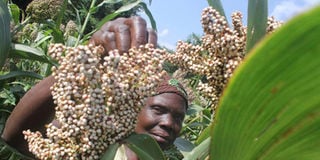Researchers release high-yielding groundnut and finger miller varieties

A farmer examines finger millet in her farm in Sidho, Muhoroni of Kisumu County.
What you need to know:
- Most farmers in Kerio Valley are still growing the Zambia groundnut variety, locally known as Cheplambus.
- Most firms that process products such as peanuts have been forced to import from Malawi to plug the shortage.
- Chelalang is for high altitudes, Tashia for medium to high altitudes while Ciankui variety for the medium altitudes.
Researchers at Egerton University in collaboration with Elgeyo-Marakwet county government are promoting the growing of traditional crops as a way of tackling food insecurity.
Prof Paul Kimurto from the university’s department of crops said that there are a number of new varieties of seeds, including those of groundnuts, that have been released in the market to enable farmers realise higher yields.
Most farmers in Kerio Valley are still growing the Zambia groundnut variety, locally known as Cheplambus, which produces about three bags per acre and takes takes months to be ready for harvesting.
The crop expert observed they released CG7, ICGV 83704 and ICGV 9704 varieties to the market, with a potential of between 30 to 40 bags per acre and matures in two-and-half months.
He said currently the country faces a huge deficit for the produce since most firms that process products such as peanuts have been forced to import from Malawi to plug the shortage.
“We conducted research and found out that the best groundnuts are those that are grown in Kerio Valley because their aflatoxin levels are low (the area has sandy soils and witnesses low rainfall),” said Prof Kimurto.
Other seeds which have been released include those of finger millet namely U15, PP24 and EU200234 while there is also EUPP 554 and EUPP 557, chickpeas varieties.
“As for sorghum, we have the Kari Mtama which the white variety is good for the use in malting while the EUSG 24004 is red variety and mainly grown for consumption,” said Prof Kimurto.
Dr Bernard Towett, a researcher at the Egerton University said that there were three bean varieties developed by the institution for various ecological zones.
He noted Chelalang was for high altitudes, Tashia for medium to high altitudes while Ciankui variety for the medium altitudes.
“They are high-yielding varieties with potential of between 12 and 15 bags per acre. Their demand is so high that we have contracted farmers to grow their seeds in five counties; Uasin Gishu, Nandi, Elgeyo-Marakwet, Bomet and Nakuru,” he said. Other attributes, said Dr Towett.
Dr Romano Kiome, Chief of Party of the Accelerated Value Chain Development Programme supported by USAID, (and former Agriculture Permanent Secretary) asked county government to allocate 20 per cent of their budget towards agriculture to support farmers.





